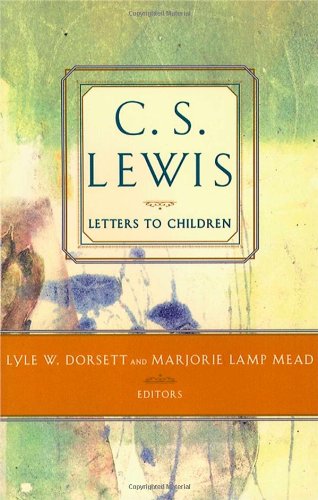Letters to Children

Lewis, C.S. Letters to Children. Eds. Lyle W. Dorsett and Marjorie Lamp Mead. New York: Macmillan Publishing Co., 1985. 120 pp. ISBN 978-0025708309.
Reviewed by Nancy-Lou Patterson
[This review originally appeared as “The Real Side-Chapels” in Mythlore 12.1 (#43) (1985): 41-42.]
Exquisitely edited so that nearly every letter is a jewel, and some are pearls of great price, this enchanting little book is a major addition to the canon of Lewis’s writings. It can be read on many levels. Literally, it reveals the charming avuncular correspondent of a multitude of children––they or their parents must have known how blest they were, as witnessed by the preservation of so many letters. Whole families of children emerge as distinct personalities from Lewis’s perceptive and responsive replies. The letters date from 16 July, 1944, when England was still at war and Lewis writes to his god-daughter Sarah of feeding an old rabbit in Magdalen Wood, to 21 November 1963, the day before his death, when he remarks that “all children who have written to me see at once who Aslan is, and grown ups never do!” (114). They thus concentrate upon the Narnian Chronicles, but the Space Trilogy and Till We Have Faces come in for comment too, as does a very wide range of literature by other writers including some sweet-natured comments by Tolkien.
Extremely poignant are the fragmentary glimpses of Lewis’s marriage to Joy Davidman—indeed, some of the most affecting comments we have on this subject as Lyle Dorsett obviously knows. The lady appears first as “a visitor … a very nice one” (30) on 26 January 1953, and we last hear of her as Lewis declines an invitation to his god-daughter’s wedding (21 November 1963): “Any wedding, for the reason you know, would turn me inside out right now” (94). This sentence, written about four months after Joy’s death, is A Grief Observed in a nutshell. Pace John Beversluis’s sour interpretation in C.S. Lewis and the Search for Rational Religion, by 15 February 196l—three months later—he is engaged in a lively discussion with the young Roman Catholic Hugh on the “glorified body of each Christian” (96), concluding, “I incline to think that tho’ the blessed will participate in the Divine Nature, they will do so always in a mode which does not simply annihilate their humanity” (97). Surely this was not written by a man who had lost his faith in reason as a way to reach toward the divine!
On another level the letters are full of significant information about Lewis’s writings and even upon his scholarship. In fact it is a little bonanza of new materials on Narnia and settles at least two points which (I speak as a fan) have stuck in my craw for a long time. One is the final fate of the pathetic little Christmas revelers turned to stone by the White Witch in The Lion, the Witch, and the Wardrobe: Lewis says to a child who has wondered about it: “You are right about the party turned into stones in the woods. I thought people would take it for granted that Aslan would put it all right. But I see now I should have said so” (33).
The other is the tendency of people to say that Susan is damned or at least doomed never to return to Narnia because she is not killed along with her siblings in The Last Battle. To this Lewis replies: “there is plenty of time for her to mend, and perhaps she will get to Aslan’s country in the end—in her own way” (67). The book is filled with similar nutshell riches and I won’t spoil your delight by revealing any more. Besides, I have made a list to save up (like David’s stones) to hurl at certain Goliaths!
A moving Foreword by Douglas Gresham, one of Lewis’s stepsons, describes his stepfather as “kind, jolly, and generous.” A nicely potted biography of “C.S. Lewis: His Childhood” precedes the letters, filled with delicious and previously unpublished anecdotes, many by Warren Lewis of his baby brother before he became Jack and was only “Babsie,” which somehow escape both condescension and sentimentality and which show us the infant moralist, before the age of two counseling his elder brother to wipe his nose.
There are in addition an extensive bibliography, useful passages of annotation, and an introduction which begins with one of the most thought-provoking quotations from Lewis that I ever encountered: “It’s fun laying out all my books as a cathedral.” In expanding upon this idea, Lewis explains, “my children’s stories are the real side-chapels, each with its own little altar” (3). Exactly. These works are chapels which invite the reader to worship God who is revealed in them. And every one of the letters in Letters to Children is a little gift of the love of God, of His creation and of humankind, laid in the hand of each child. And since we have been told to become as little children, this book is a gift for the rest of us too.

